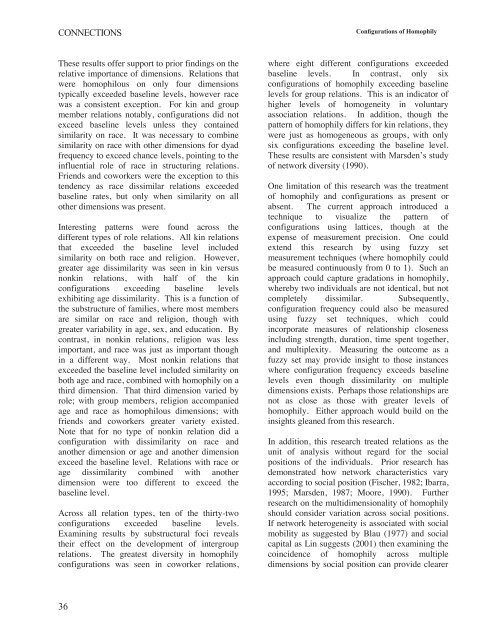CONNECTIONS - INSNA
CONNECTIONS - INSNA
CONNECTIONS - INSNA
You also want an ePaper? Increase the reach of your titles
YUMPU automatically turns print PDFs into web optimized ePapers that Google loves.
<strong>CONNECTIONS</strong><br />
Configurations of Homophily<br />
These results offer support to prior findings on the<br />
relative importance of dimensions. Relations that<br />
were homophilous on only four dimensions<br />
typically exceeded baseline levels, however race<br />
was a consistent exception. For kin and group<br />
member relations notably, configurations did not<br />
exceed baseline levels unless they contained<br />
similarity on race. It was necessary to combine<br />
similarity on race with other dimensions for dyad<br />
frequency to exceed chance levels, pointing to the<br />
influential role of race in structuring relations.<br />
Friends and coworkers were the exception to this<br />
tendency as race dissimilar relations exceeded<br />
baseline rates, but only when similarity on all<br />
other dimensions was present.<br />
Interesting patterns were found across the<br />
different types of role relations. All kin relations<br />
that exceeded the baseline level included<br />
similarity on both race and religion. However,<br />
greater age dissimilarity was seen in kin versus<br />
nonkin relations, with half of the kin<br />
configurations exceeding baseline levels<br />
exhibiting age dissimilarity. This is a function of<br />
the substructure of families, where most members<br />
are similar on race and religion, though with<br />
greater variability in age, sex, and education. By<br />
contrast, in nonkin relations, religion was less<br />
important, and race was just as important though<br />
in a different way. Most nonkin relations that<br />
exceeded the baseline level included similarity on<br />
both age and race, combined with homophily on a<br />
third dimension. That third dimension varied by<br />
role; with group members, religion accompanied<br />
age and race as homophilous dimensions; with<br />
friends and coworkers greater variety existed.<br />
Note that for no type of nonkin relation did a<br />
configuration with dissimilarity on race and<br />
another dimension or age and another dimension<br />
exceed the baseline level. Relations with race or<br />
age dissimilarity combined with another<br />
dimension were too different to exceed the<br />
baseline level.<br />
Across all relation types, ten of the thirty-two<br />
configurations exceeded baseline levels.<br />
Examining results by substructural foci reveals<br />
their effect on the development of intergroup<br />
relations. The greatest diversity in homophily<br />
configurations was seen in coworker relations,<br />
where eight different configurations exceeded<br />
baseline levels. In contrast, only six<br />
configurations of homophily exceeding baseline<br />
levels for group relations. This is an indicator of<br />
higher levels of homogeneity in voluntary<br />
association relations. In addition, though the<br />
pattern of homophily differs for kin relations, they<br />
were just as homogeneous as groups, with only<br />
six configurations exceeding the baseline level.<br />
These results are consistent with Marsden’s study<br />
of network diversity (1990).<br />
One limitation of this research was the treatment<br />
of homophily and configurations as present or<br />
absent. The current approach introduced a<br />
technique to visualize the pattern of<br />
configurations using lattices, though at the<br />
expense of measurement precision. One could<br />
extend this research by using fuzzy set<br />
measurement techniques (where homophily could<br />
be measured continuously from 0 to 1). Such an<br />
approach could capture gradations in homophily,<br />
whereby two individuals are not identical, but not<br />
completely dissimilar. Subsequently,<br />
configuration frequency could also be measured<br />
using fuzzy set techniques, which could<br />
incorporate measures of relationship closeness<br />
including strength, duration, time spent together,<br />
and multiplexity. Measuring the outcome as a<br />
fuzzy set may provide insight to those instances<br />
where configuration frequency exceeds baseline<br />
levels even though dissimilarity on multiple<br />
dimensions exists. Perhaps those relationships are<br />
not as close as those with greater levels of<br />
homophily. Either approach would build on the<br />
insights gleaned from this research.<br />
In addition, this research treated relations as the<br />
unit of analysis without regard for the social<br />
positions of the individuals. Prior research has<br />
demonstrated how network characteristics vary<br />
according to social position (Fischer, 1982; Ibarra,<br />
1995; Marsden, 1987; Moore, 1990). Further<br />
research on the multidimensionality of homophily<br />
should consider variation across social positions.<br />
If network heterogeneity is associated with social<br />
mobility as suggested by Blau (1977) and social<br />
capital as Lin suggests (2001) then examining the<br />
coincidence of homophily across multiple<br />
dimensions by social position can provide clearer<br />
36
















